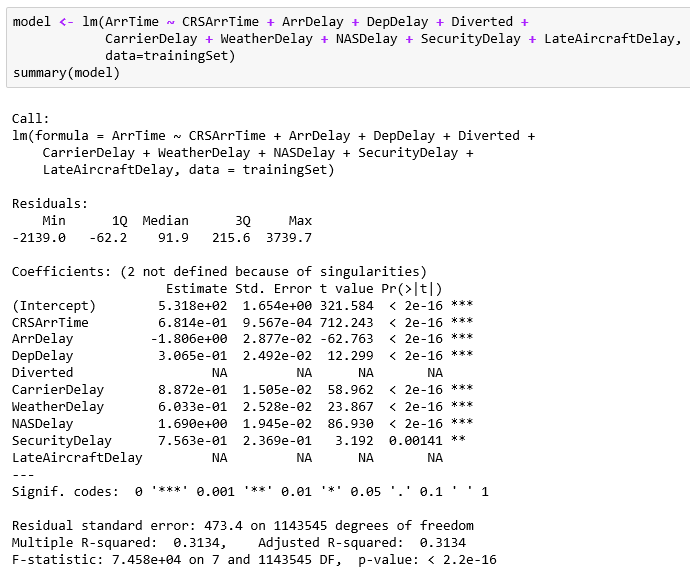R has built-in functionality for splitting up a data frame between training and testing sets, building a model based on the training set, predicting results using the model and the testing set, and then visualizing how well the model is working.
For this example, I am using airline arrival and departure times versus scheduled arrival and departure times from http://stat-computing.org/dataexpo/2009/the-data.html for 2008. The dataset is distributed as a .bz2 file that unpacks into a CSV file. I like this dataset, as the initial row count is over 7 million and it all works nicely in Jupyter.
We first read in the airplane data and display a summary. There are additional columns in the dataset that we are not using:
df <- read.csv("Documents/2008-airplane.csv")
summary(df)
...
CRSElapsedTime AirTime ArrDelay DepDelay
Min. :-141.0 Min. : 0 Min. :-519.00 Min. :-534.00
1st Qu.: 80.0 1st Qu.: 55 1st Qu.: -10.00 1st Qu.: -4.00
Median : 110.0 Median : 86 Median : -2.00 Median : -1.00
Mean : 128.9 Mean : 104 Mean : 8.17 Mean : 9.97
3rd Qu.: 159.0 3rd Qu.: 132 3rd Qu.: 12.00 3rd Qu.: 8.00
Max. :1435.0 Max. :1350 Max. :2461.00 Max. :2467.00
NA's :844 NA's :154699 NA's :154699 NA's :136246
Origin Dest Distance TaxiIn
ATL : 414513 ATL : 414521 Min. : 11.0 Min. : 0.00
ORD : 350380 ORD : 350452 1st Qu.: 325.0 1st Qu.: 4.00
DFW : 281281 DFW : 281401 Median : 581.0 Median : 6.00
DEN : 241443 DEN : 241470 Mean : 726.4 Mean : 6.86
LAX : 215608 LAX : 215685 3rd Qu.: 954.0 3rd Qu.: 8.00
PHX : 199408 PHX : 199416 Max. :4962.0 Max. :308.00
(Other):5307095 (Other):5306783 NA's :151649
TaxiOut Cancelled CancellationCode Diverted
Min. : 0.00 Min. :0.00000 :6872294 Min. :0.000000
1st Qu.: 10.00 1st Qu.:0.00000 A: 54330 1st Qu.:0.000000
Median : 14.00 Median :0.00000 B: 54904 Median :0.000000
Mean : 16.45 Mean :0.01961 C: 28188 Mean :0.002463
3rd Qu.: 19.00 3rd Qu.:0.00000 D: 12 3rd Qu.:0.000000
Max. :429.00 Max. :1.00000 Max. :1.000000
NA's :137058
CarrierDelay WeatherDelay NASDelay SecurityDelay
Min. : 0 Min. : 0 Min. : 0 Min. : 0
1st Qu.: 0 1st Qu.: 0 1st Qu.: 0 1st Qu.: 0
Median : 0 Median : 0 Median : 6 Median : 0
Mean : 16 Mean : 3 Mean : 17 Mean : 0
3rd Qu.: 16 3rd Qu.: 0 3rd Qu.: 21 3rd Qu.: 0
Max. :2436 Max. :1352 Max. :1357 Max. :392
NA's :5484993 NA's :5484993 NA's :5484993 NA's :5484993
LateAircraftDelay
Min. : 0
1st Qu.: 0
Median : 0
Mean : 21
3rd Qu.: 26
Max. :1316
NA's :5484993
# eliminate rows with NA values df <- na.omit(df)
Let's create our partitions:
# for partitioning to work data has to be ordered times <- df[order(df$ArrTime),] nrow(times) 1524735 # partition data - 75% training library(caret) set.seed(1337) trainingIndices <- createDataPartition(df$ArrTime,p=0.75,list=FALSE) trainingSet <- df[trainingIndices,] testingSet <- df[-trainingIndices,] nrow(trainingSet) nrow(testingSet) 1143553 381182
Let's build our model of the arrival time (ArrTime) based on the fields:
- CRSArrTime: Scheduled arrival time
- ArrDelay: Arrival delay
- DepDelay: Departure delay
- Diverted: Whether the plane used a diverted route
- CarrierDelay: Delay by the carrier systems
- WeatherDelay: Delay due to weather
- NASDelay: Delay due to NAS
- SecurityDelay: Delay due to security
- LateAircraftDelay: Plane arrived late due to other delay

Two of the data items are just flags (0/1), unfortunately. The greatest predictor appears to be the scheduled arrival time. The other various delay factors have small effects. I think it just feels as if it's taking an extra 20 minutes for a security check or the like; it's a big deal when you are traveling.
Now that we have a model, let's use the testing set to make predictions:
predicted <- predict(model, newdata=testingSet)
summary(predicted)
summary(testingSet$ArrTime)
Min. 1st Qu. Median Mean 3rd Qu. Max.
-941 1360 1629 1590 1843 2217
Min. 1st Qu. Median Mean 3rd Qu. Max.
1 1249 1711 1590 2034 2400
Plot out the predicted versus actual data to get a sense of the model's accuracy:
plot(predicted,testingSet$ArrTime)

Visually, the predictions match up well with the actuals as shown by the almost 45 degree line. That whole set of predicted points on the lower-right portion of the graphic is troublesome. There appears to be many predictions that are well below the actuals. There must be additional factors involved, as I would have expected all of the data to plot in one area rather than two.
